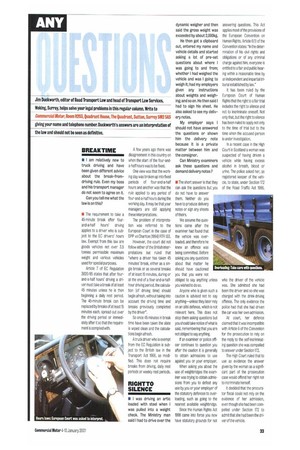RIGHTTO SILENCE
Page 35

If you've noticed an error in this article please click here to report it so we can fix it.
• I was driving an artic loaded with steel when I was pulled into a weight check. The Ministry man said I had to drive over the dynamic weigher and then said the gross weight was exceeded by about 2,000kg.
He then got a clipboard out, entered my name and vehicle details and started asking a lot of pre-set questions about where I was going to and from; whether I had weighed the vehicle and was I going to weigh It; had my employers given any instructions about weights and weighing; and so an. He then said I had to sign his sheet. He also asked to see my delivery notes.
My employer says I should not have answered the questions or shown him the delivery note because It Is a private matter between him and the consignor.
Can Ministry examiners ask these questions and demand delivery notes ?
• The short answer is that they can ask the questions but you do not have to answer them. Neither do you have to produce delivery notes or sign any sheets of theirs.
We assume the questions came after the examiner had found that the vehicle was overloaded, and therefore he knew an offence was being committed. Before asking you any questions about that matter he should have cautioned you that you were not obliged to say anything unless you wished to do so.
Anyone who is given such a caution is advised not to say anything—unless they later rely on an alibi defence, which is not relevant here. This does not stop them asking questions but you should take notice of what is said, remembering that you are not obliged to say anything.
If an examiner or police officer continues to question you after the caution it is generally to obtain admissions to use against you or your employer.
When asking you about the use of weighbridges the examiner was trying to obtain admissions from you to defeat any use by you or your employer of the statutory defences to overloading, such as going to the nearest available weighbridge.
Since the Human Rights Act 1998 came into force you now have statutory grounds for not answering questions. This Act applies most of the provisions of the European Convention on Human Rights. Article 6(1) of the Convention states: "In the determination of his civil rights and obligations or of any criminal charge against him, everyone is entitled to a fair and public hearing within a reasonable time by an independent and impartial tribunal established by law."
It has been ruled by the European Court of Human Rights that the right to a fair trial includes the right to silence and not to incriminate oneself. Not only that, but the right to silence has been ruled to apply not only to the time of trial but to the time when the accused person is under investigation.
In a recent case in the High Court in Scotland a woman was suspected of having driven a vehicle while having excess alcohol in breath, blood or urine. The police asked her, as registered keeper of the vehicle, to state, under Section 172 of the Road Traffic Act 1986, who the driver of the vehicle was. She admitted she had been the driver and so she was charged with the drink-driving offence. The only evidence the police had that she had driven the car was her own admission.
At court, her defence claimed that it was incompatible with Article 6 of the Convention for the prosecution to rely on the reply to the self-incriminating question she was compelled to answer under Section 172.
The High Court ruled that to use as evidence the answer given by the woman as a significant part of the prosecution case would offend her right not to incriminate herself.
It decided that the procurator fiscal could not rely on the evidence of her admission, even though she had been compelled under Section 172 to admit that she had been the driver of the vehicle.




























































































